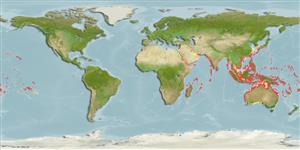Issue
Kyphosus species analogus (E. Pacific) and incisor (Atlantic) in Knudsen and Clements, 2013 (Ref. 95491:65) were considered as synonyms of K. vaigiensis.
Environment: milieu / climate zone / depth range / distribution range
Ecología
marino asociado a arrecife; oceanodromo (Ref. 51243); rango de profundidad 0 - 40 m (Ref. 89972). Tropical; 35°N - 38°S, 25°E - 133°W
Circumtropical: from the eastern Pacific across the Pacific Ocean to the Indian
Ocean, the Red Sea and the eastern and western Atlantic and the Mediterranean.
Length at first maturity / Tamaño / Peso / Age
Maturity: Lm ?, range 39 - ? cm
Max length : 70.0 cm TL macho / no sexado; (Ref. 559); common length : 50.0 cm TL macho / no sexado; (Ref. 5450)
Espinas dorsales (total): 10 - 11; Radios blandos dorsales (total): 13-15; Espinas anales 3; Radios blandos anales: 12 - 14; Vértebra: 26. This species is distinguished by the following characters: elongate and oval-shaped body; scale rows horizontally along the body appear alternately golden and bluish; metallic blue dorsally and white ventrally; caudal fin moderately emarginated; very low dorsal and anal fins; D X-XI,13-15; A III, 12-14; pectoral fin 17-20: teeth incisor-shaped; scales on interorbital region; external side of first gill arch with high number of gill rakers on lower limb 16-23, upper limb 5-10; total lateral line scale rows 63-80, 52-63 has pores; longitudinal scale rows 56-70; vertebrae: precaudal 10, caudal 16; pterygiophores, anal 13-14, dorsal 22-24. Colour of body silvery with a bluish shine, with golden horizontal lines along the body (around 23-29), dorsal lines above lateral line curved along the lateral line;; golden streak beneath eye from snout to behind anterior edge of eye; fins are grey or slightly darker grey than body colour (Ref. 95491).
Aggregate over hard, algal coated bottoms of exposed surf-swept outer reef flats, lagoons, and seaward reefs to a depth of at least 24 m. Found in exposed areas around rocky reefs (Ref. 559); adults usually close to the shore and the coastline, while juveniles are associated with flotsam and can be encountered in the open ocean close to the surface (Ref. 95491). Benthopelagic (Ref. 58302). Usually in groups (Ref. 90102). Young (up to 5 cm) found among floating seaweed; feeding on small crustaceans (Ref. 559). Adults are carnivorous during summer and autumn but feed on Endarachne binghamiae during winter (Ref. 559). Good food fish (Ref. 559). Minimum depth reported taken from Ref. 30573.
Life cycle and mating behavior
Madurez | Reproducción | Puesta | Huevos | Fecundidad | Larva
Knudsen, S.W. and K.D. Clements, 2013. Revision of the fish family Kyphosidae (Teleostei: Perciformes). Zootaxa 3751(1):001-101. (Ref. 95491)
IUCN Red List Status (Ref. 130435)
Threat to humans
Harmless
Human uses
Pesquerías: comercial; pesca deportiva: si
Más información
ReferenciasAcuiculturaPerfil de acuiculturaRazasGenéticaElectrophoresesheritabilidadEnfermedadesProcesamientoNutrientsMass conversion
Herramientas
Special reports
Download XML
Fuentes de Internet
Estimates based on models
Preferred temperature (Ref.
123201): 24.7 - 29, mean 27.8 °C (based on 896 cells).
Phylogenetic diversity index (Ref.
82804): PD
50 = 0.5000 [Uniqueness, from 0.5 = low to 2.0 = high].
Bayesian length-weight: a=0.01778 (0.01117 - 0.02831), b=3.00 (2.87 - 3.13), in cm total length, based on LWR estimates for this species & (Sub)family-body (Ref.
93245).
Nivel trófico (Ref.
69278): 2.0 ±0.0 se; based on diet studies.
Resiliencia (Ref.
120179): Bajo, población duplicada en un tiempo mínimo de 4.5-14 años (Preliminary K or Fecundity.).
Fishing Vulnerability (Ref.
59153): Moderate to high vulnerability (48 of 100).
Nutrients (Ref.
124155): Calcium = 34 [16, 63] mg/100g; Iron = 0.517 [0.303, 0.890] mg/100g; Protein = 18.2 [16.8, 19.5] %; Omega3 = 0.0772 [, ] g/100g; Selenium = 42 [21, 89] μg/100g; VitaminA = 32.6 [6.9, 140.7] μg/100g; Zinc = 1.24 [0.84, 1.85] mg/100g (wet weight);
